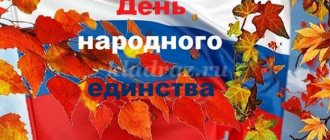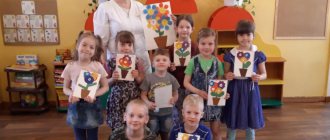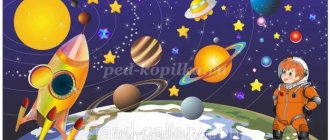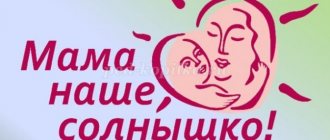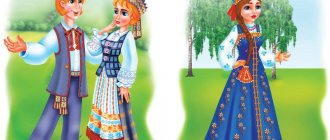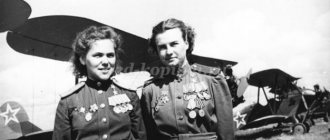Educational hour: “June 12 is Russia Day.”
Educational hour: “June 12 is Russia Day.”
Goals: Formation in children of moral and patriotic feelings towards the large, multinational Motherland - Russia.
Tasks:
Educational: introduce children to the holiday “Russia Day”, with the symbols of the state.
Developmental: increase the intellectual level, develop the manifestation of independent creative activity. Educational: develop in children a sense of love, respect, pride for their homeland.
Equipment and materials: computer, videos about Russia.
Progress of the event
Motherland! Everyone knows this word from childhood. Homeland is the place where you were born, where you live with your parents, with your friends.
Today our country celebrates Russia Day.
Russia! Like a Blue Bird, we protect and honor you, and if they violate the border, we will protect you with our breasts!
And if we were suddenly asked: “Why is the country dear to you?” - Yes, because for all of us Russia, Like our own mother, is one!
Russia Day, celebrated annually on June 12, is a very young holiday, but this day can confidently be called the birthday of the Russian Federation, since on this day in 1990 the “Declaration of State Sovereignty of the RSFSR” was adopted. The Russian Federation retained the status of a multinational state, where every nation received equal rights.
Exactly a year later, on June 12, 1991, the first popular democratic elections of the President of the Russian Federation were held, in which Boris Yeltsin was elected head of the country.
In 1994, the head of the country signed a decree establishing a new public holiday - the Day of Adoption of the Declaration of State Sovereignty of Russia. June 12 has long been called Independence Day. In 2002, the holiday was renamed “Russia Day”.
The meaning of this holiday is simple - national unity and shared responsibility for the future of the country.
Russia is the largest country in the world. Russia's borders run both by land and sea. Our country is very beautiful and rich.
Every person living on our planet feels a sense of pride in their homeland, their people and country, their land and its history. And its symbols represent the native land. Symbols are signs that distinguish our country from other countries.
Russia, like any state, has official symbols - the coat of arms, flag and national anthem. They have special meaning.
Let's talk about the flag. Listen to the poem.
The three stripes of the flag are for a reason: The white stripe is peace and purity, The blue stripe is the color of the sky, Decorated domes, joy, miracles, The red stripe is the exploits of soldiers who protect their Fatherland from enemies. He is the most important sign of a great country - our valiant tricolor Russian flag!
The national flag of the Russian Federation is constantly raised on the buildings of the authorities of our country, on the buildings of Russian diplomatic missions abroad, and is hung on public holidays and ceremonies. The flag is our shrine, and we must treat it with respect and reverence.
Now let's talk about our coat of arms.
The coat of arms of Russia is not simple: On the shield is a golden eagle, crowned, double-headed, holding a scepter and an orb.
This royal bird vigilantly looks at the borders of its State and protects its peace.
The eagle has a breast shield - The warrior is sitting on a horse. He pierces the snake with a spear and saves the Motherland from evil.
The coat of arms of Russia can be seen on the buildings of the most important government institutions, on official seals and document forms, on banknotes, on state awards, and on border posts.
The golden double-headed eagle is depicted against the background of a red shield, its wings look like the rays of the sun, and the golden bird itself looks like the sun. And this is no coincidence, because Russian people have worshiped the sun since ancient times. The eagle holds a scepter in its right paw, and an orb in its left. The scepter and the orb are symbols of Russia that remind us of the historical past of our homeland and show us the unity of the Russian Federation
On the eagle's chest there is a red shield with the image of a horseman. This is Saint George the Victorious. He was revered as a hero and as the patron saint of warriors, defenders of the Fatherland. And the Black Snake is a symbol of evil. The warrior hero's faithful horse tramples the dragon with its hooves.
Now guys, listen to another poem about our anthem.
What is an anthem anyway? The main song in the country! The Russian anthem contains the following words: “Russia is our beloved country.” We are proud of Russia, we are loyal to Russia, and there is no better country in the world. The words were written by Sergei Mikhalkov. The meaning of these words is clear and close to us. And Alexandrov composed the notes and completed the work on the anthem. We always listen to the anthem standing and silently: It is played for us at the moment of celebration!
The word "hymn" is of Greek origin and means "solemn song of praise." The anthem is performed on special, most important occasions
The text of the anthem was written by the famous Soviet writer S. V. Mikhalkov, and the music was written by composer and conductor A. V. Alexandrov. The national anthem of the Russian Federation was approved by the State Duma in December 2000. The text of the anthem was approved by decree of the President of Russia V.V. Putin on December 30. 2000 So, on the eve of the New Year and the New Century, Russia had a new anthem.
The solemn sounds of the anthem unite the nation, instill in it a sense of pride for their Motherland, and inspire the people to new achievements - this is the idea of the anthem.
The Russian national anthem is performed at official events: during the inauguration of the president, heads of government bodies; when meeting and seeing off heads of foreign states; during ceremonies of sports competitions, etc.
In addition to traditional symbols in the form of a coat of arms, flag and anthem, Russia has a number of other unofficial symbols that denote history, culture and way of life.
Guys, name the unofficial symbols that, in your opinion, characterize Russia.
(Children's answers)
Red Square as a symbol of the unity of Russia, the heroism of the Russian people. The Kremlin is the symbol of Russia's top leadership.
The Kremlin chimes on the Spasskaya Tower have long become a symbol not only of Red Square, but also of the accuracy, reliability and inviolability of Russia
The birch has always been considered a symbol of Russia, a symbol of its spirituality, prosperity and longevity.
Matryoshka dolls are an unofficial symbol of Russia. A symbol of her soul, mysterious to everyone.
The bear is a majestic animal that occupies an exceptional position among other animals. It is no coincidence that many Russian cities (Yaroslavl, Novgorod, etc.) have his image on their coats of arms, and the bear itself is an unofficial symbol of Russia and the Russian people.
The Tula samovar is a symbol of Russian hospitality. The samovar personified the everyday aspects of the Russian way of life
The balalaika is one of the instruments that has become the musical symbol of the Russian people.
Second part. Game "My Russia!"
Well, now we will play with you. To do this, you will remember everything we just talked about and answer my questions. For each correct answer you will receive a token, and at the end of the game we will count them and determine the winner.
Questions: 1. What is the name of the country in which we live? (Russia) 2. What is the name of the place where a person was born and raised? (Motherland)
3..The most important city in each country? (Capital) 4. Which city is the capital of our state? (Moscow) 5. What are the people of our country called? (Russians) 6. The most important person in the country, who received the right to power from the people? (The president). 7. In what year were the first popular presidential elections held? (June 12, 1991) 8. In what year was the decree on the establishment of a new public holiday “Day of Adoption of the Declaration of State Sovereignty of Russia” signed? (June 12, 1994) 9. In what year was the holiday renamed “Russia Day”? (2002) 10..What symbols of the state do you know? (Flag, coat of arms, anthem) 11. What is the name of the symbol image that shows the historical traditions of the city or state? (Coat of arms) 12.What is depicted on the coat of arms? (Double-headed eagle, on the eagle’s chest there is a red rectangle with the image of a horseman killing a dragon). 13.What does St. George the Victorious pierce the dragon with? (with a spear) 14.Which coin was given its name by the spear? (kopeck) 15. Which tree is a symbol of Russia? (Birch) 16.What is the name of the famous Russian clamshell toy? (matryoshka). 17.Majestic animal - a symbol of Russia? (bear). 18. What is the name of the solemn song of praise performed on especially solemn occasions? (Anthem) 19.What actions do people show respect for the state whose anthem is being played? (stand up) 20.Who is the author of the text of the Russian anthem? (S.V. Mikhalkov) 21. Symbol of Russian hospitality? (samovar). 22.Is a musical instrument a symbol of Russia? (balalaika). 23.. How many colors does the Russian flag have, what are they? (Three: white, blue, red) 24. What does the white color of the Russian flag mean? (White color denotes purity of aspirations) 25. What does the blue color of the Russian flag mean? (Blue - the will to peace) 26. What does the red color of the Russian flag mean? (Red - readiness not to spare one’s blood in defense of the Motherland)
Well done guys, now let’s continue and add the missing ending to the proverbs.
The 2nd competition is announced. The proverb goes by the way.
1.Away is good, but at home (better). 2. Every sandpiper praises its own swamp. 3. Where someone was born, there (it came in handy). 4.If the people are united, they will not (win). 5.Native side - mother. Alien - (stepmother). 6. From your native land - die, (don’t leave). 7. A person without a homeland is like a bird without (wings). 8. Foreign land - viburnum, Motherland - (raspberry). 9.Live – serve the Motherland (serve). 10. Moscow - to all cities (mother). 11. The peoples of our country are (strong) in friendship. 12. On the other side, the Motherland is (doubly) miles away. 13. There is no more beautiful Motherland in the world (ours). 14. The Motherland is a mother, know how to (stand up for) her.
Well done guys, good job. And I want to finish our lesson with another poem about our beautiful Motherland.
What is Russia? This is a hot summer, When there are many flowers in the green meadow, When the splashes on the sea are pearl-colored, When the bread ripens and the grass is cut.
What is Russia? This is a wonderful autumn, When cranes fly in the sky, whirring, When ripe cones fall from pine trees, When leaves swirl all the way to the ground.
What is Russia? This is a winter fairy tale, When silver snow lies on the ground, When boys rush down the mountain on sleds, When the pattern on the window glass is visible.
What is Russia? This is a spring full of life, Happiness, cheerfulness, joy, light, When cool rain suddenly splashes on the ground,
When the forest begins to rustle, having recovered from sleep, When the wind stirs the young grass, When the birds sing again in our land. I love my Russia, my native land, Like a dear mother, I love it very tenderly!
For the little ones
Pushkin, Aksakov, Turgenev - they all mentioned in their memoirs that they owe their love for the Russian language and culture to folk tales and songs that peasant nannies brought to them. It is difficult for a small child to delve into historical processes and understand what civic duty or civil rights are. His path to the Russian spirit begins with fairy tales, epics, nursery rhymes, painted nesting dolls and clay whistles, an embroidered towel, a carved figurine of a forester or Baba Yaga.
Read a folk or original fairy tale with your children. Read an epic or watch a cartoon about Russian heroes. Find interesting facts - that Ilya Muromets, Dobrynya Nikitich, Vladimir Krasno Solnyshko were real historical characters who left their mark on folklore. With older children, you can read more complex epics, for example, “Avdotya-Ryazanochka,” which tells about the Tatar-Mongol conquest.
If time and opportunities allow, you can arrange an excursion to the Kremlin, one of the parks with estates, a museum of folk toys, or even go on a weekend trip to Myshkin, Suzdal, Vladimir. You should not overload your child with knowledge - the atmosphere of a holiday, travel itself will awaken a natural interest in him, you will only have to answer questions.
My kindergarten
Author: Nikitina Irina Yurievna , teacher, Municipal budgetary preschool educational institution “Child Development Center - kindergarten N16 “Inspiration”, Yurga.
Goals:
- Introduce children to the image of the National Flag (color scheme, arrangement of stripes);
- To form an idea of the meaning of the State Flag of the Russian Federation.
Flag Day is celebrated today by All Rus', without edge and end, And everyone firmly magnifies, This symbol is the pride of the crown. After all, there is no country in the world without a flag, But this one is dearest to us, It contains honor and pride and courage, From the past to the present day. Let the flag fly carelessly, Preserving our native land, And we, with eternal gratitude, will bow to it more than once.
By Decree of the President of the Russian Federation of April 15, 1994 N1714.
On August 22, Russia celebrates one of the main holidays, National Flag Day! Each state has its own symbols. These are the coat of arms, flag and anthem. This is not just a pretty image. It is the embodiment of history and an expression of the patriotism of citizens. Therefore, we all must know and respect the history of state symbols.
Any flag has a symbolic meaning. To “read” the coat of arms and flag of the state, you need to know the meaning of the colors and images. The definition of symbolic meaning depends on the national traditions and ethnocultural characteristics of the country. The colors and arrangement of stripes of the Russian flag give an idea of the structure of the world, accepted in Russian traditional culture. The Russian flag signifies the unity of the country and its independence from other countries.
Why are the stripes arranged this way and not otherwise? The red stripe is our beautiful, beautiful land, where sometimes, unfortunately, wars happen and blood is shed. Above the ground there is a blue sky. This is the blue stripe. And above the earth and sky there is everything that is purest, brightest, most beautiful, a certain Divine power, or, as they say, the Lord God.
In Rus', these colors have been revered from time immemorial: they were used to decorate homes, patterns on clothes, the Russian tricolor, letters, photographs, transport, etc.
The horizontal arrangement of the stripes was determined by the idea of the structure of the world: Above - the sky - blue; At the very bottom is the world of people. It is no coincidence that these colors are also combined in the coat of arms, where the colors have their own meaning: White - St. George the Victorious, Blue - the fluttering cloak of the horseman, Red - the background and shield of the coat of arms.
The image of a horseman striking a black dragon with a spear means the victory of good and justice over evil.
“Two eagles carry a chariot across the world, in the center the driver rules a pair of birds, and above is the sun itself; two wings of his sister - Morning Dawn and Evening Dawn” - this is how the folk legend explains the meaning.
Of course, over time, the poetic meaning was forgotten, and the sun chariot was replaced by a double-headed eagle.
The coat of arms appeared in 1497. The eagle is a symbol of the sun, heavenly power, fire and immortality. One head is the ruler of the state, Tsar Ivan Vasilyevich - the Grand Duke of All Rus'. The other is the ruler of the Orthodox Church, Patriarch of All Rus', Philanthropist.
The heads are located on one body - this is the unity of Rus', moreover, the tsar and the patriarch were siblings. Subsequently, the eagle remained with two heads, as a symbol of the unity of spiritual and secular power.
Literature
- E. K. Rivina “ Coat of arms and flag of Russia ”. 2002
- E. K. Rivina “ Russian symbols ” . Arkti – Moscow 2004
- A. Ivanov “My Motherland is Russia.” 2011
- E. L. Erokhina. “Government structure of Russia.” Album for activities with children 6 - 7 years old.
- “My Motherland – Russia Coat of Arms, Anthem, Flag of Russia.” Schoolchildren's reference book publishing house “Litera”
- O. N. Barannikova “Lessons in citizenship and patriotism in kindergarten.” Arkti Publishing House - Moscow 2007.
